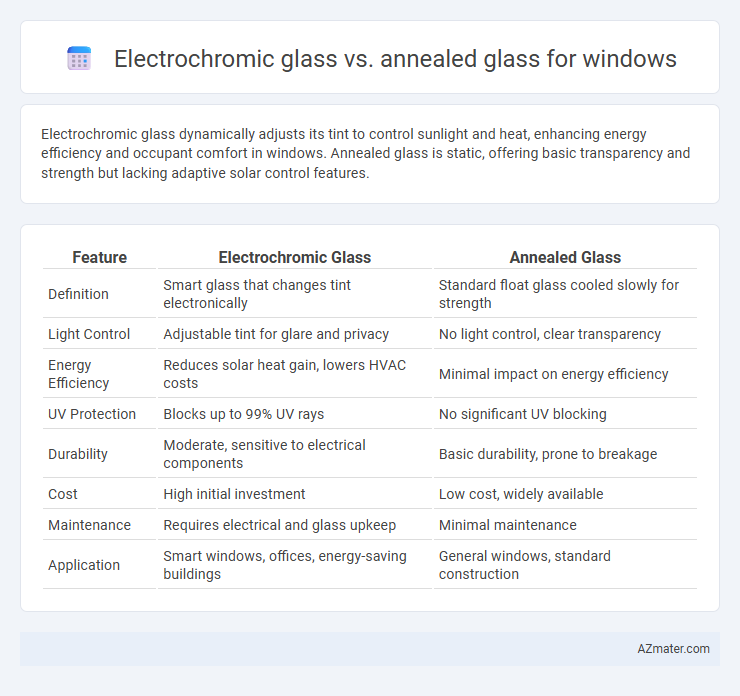Electrochromic glass dynamically adjusts its tint to control sunlight and heat, enhancing energy efficiency and occupant comfort in windows. Annealed glass is static, offering basic transparency and strength but lacking adaptive solar control features.
Table of Comparison
| Feature | Electrochromic Glass | Annealed Glass |
|---|---|---|
| Definition | Smart glass that changes tint electronically | Standard float glass cooled slowly for strength |
| Light Control | Adjustable tint for glare and privacy | No light control, clear transparency |
| Energy Efficiency | Reduces solar heat gain, lowers HVAC costs | Minimal impact on energy efficiency |
| UV Protection | Blocks up to 99% UV rays | No significant UV blocking |
| Durability | Moderate, sensitive to electrical components | Basic durability, prone to breakage |
| Cost | High initial investment | Low cost, widely available |
| Maintenance | Requires electrical and glass upkeep | Minimal maintenance |
| Application | Smart windows, offices, energy-saving buildings | General windows, standard construction |
Introduction to Electrochromic Glass and Annealed Glass
Electrochromic glass features a dynamic tinting capability, allowing windows to change transparency in response to electrical voltage, enhancing energy efficiency and glare control. Annealed glass, by contrast, is standard float glass cooled slowly after production to reduce internal stresses, offering baseline safety and clarity but lacking adaptive properties. The integration of electrochromic technology in windows provides superior control over solar heat gain compared to traditional annealed glass.
How Electrochromic Glass Works
Electrochromic glass controls light and heat transmission by altering its tint through an electrical charge applied to its layered structure, which includes electrochromic materials, ion storage layers, and conductive electrodes. This smart glass technology shifts from transparent to opaque by reversible redox reactions that modulate the absorption of light and solar energy, reducing glare and improving energy efficiency. Annealed glass, in contrast, is a static material without dynamic light modulation, simply providing basic transparency and strength without changing its optical properties.
Understanding Annealed Glass
Annealed glass is a basic type of glass produced by slowly cooling molten glass to relieve internal stresses, resulting in a smooth, clear surface ideal for standard window applications. Unlike electrochromic glass, annealed glass does not have the ability to change its tint or transparency in response to electrical stimuli, making it less effective for energy-saving or privacy functions. Its primary advantages lie in cost-effectiveness and ease of cutting or shaping before installation, but it lacks the dynamic light control and UV protection features offered by advanced electrochromic technology.
Energy Efficiency Comparison
Electrochromic glass enhances energy efficiency by dynamically controlling solar heat gain, reducing cooling loads by up to 20% compared to traditional annealed glass. Annealed glass lacks adaptive properties, resulting in higher energy consumption for heating and cooling due to constant heat transfer. Implementing electrochromic glass can lead to significant HVAC energy savings and improved occupant comfort through automated tint adjustments.
Light Control and Privacy Features
Electrochromic glass offers dynamic light control by electronically adjusting transparency levels, enabling precise management of glare and solar heat gain, which enhances energy efficiency and occupant comfort. Annealed glass provides static light transmission without modulation, resulting in consistent natural daylight but limited privacy control features. For privacy, electrochromic glass can switch from clear to opaque states, ensuring on-demand privacy, whereas annealed glass requires additional treatments like blinds or films to achieve similar effects.
Durability and Safety Aspects
Electrochromic glass offers enhanced durability due to its multi-layered construction and ability to self-tint, reducing UV exposure and minimizing internal stress, whereas annealed glass is more susceptible to breakage under impact or thermal stress. In safety terms, electrochromic glass often incorporates laminated or tempered layers, providing better resistance to shattering and improved occupant protection compared to standard annealed glass which can break into sharp shards. Selecting electrochromic glass significantly increases window longevity and safety, making it more suitable for applications requiring both durability and impact resistance.
Cost Analysis: Initial and Long-Term Investment
Electrochromic glass typically involves a higher initial investment compared to annealed glass due to advanced technology and installation complexity, often costing between $50 to $100 per square foot. Long-term savings emerge from significant energy efficiency, reducing HVAC expenses by up to 20%, whereas annealed glass has minimal energy-saving properties and lower upfront costs, around $10 to $20 per square foot. Considering maintenance and replacement costs, electrochromic glass provides a better return on investment over 10-15 years, offsetting its premium price through utility bill reductions and increased building value.
Applications in Modern Architecture
Electrochromic glass offers dynamic solar control by tinting on demand, enhancing energy efficiency and occupant comfort in modern architecture, suitable for smart facades and responsive building envelopes. Annealed glass, known for its basic transparency and strength, is primarily used in traditional window applications but lacks adaptive light modulation capabilities. The integration of electrochromic glass in commercial and residential buildings supports sustainable design trends by reducing HVAC loads and glare, surpassing the static performance of annealed glass.
Environmental Impact and Sustainability
Electrochromic glass significantly reduces energy consumption by dynamically controlling solar heat and glare, leading to lower HVAC emissions compared to traditional annealed glass. This smart glass enhances sustainability through increased energy efficiency and reduced reliance on artificial lighting and cooling systems. In contrast, annealed glass offers minimal environmental benefits, as it lacks adaptive properties and contributes to higher operational carbon footprints in buildings.
Choosing the Right Glass for Your Windows
Electrochromic glass offers dynamic tinting ability, providing energy savings and enhanced privacy by adjusting light transmission levels automatically or manually, whereas annealed glass is a standard non-tinted option known for its basic insulation and durability. When choosing glass for windows, consider factors such as energy efficiency, UV protection, privacy needs, and budget constraints; electrochromic glass excels in smart building applications with variable light control. Selecting the right glass depends on balancing advanced features like solar heat gain reduction and glare control against cost-effectiveness and installation requirements.

Infographic: Electrochromic glass vs Annealed glass for Window
 azmater.com
azmater.com